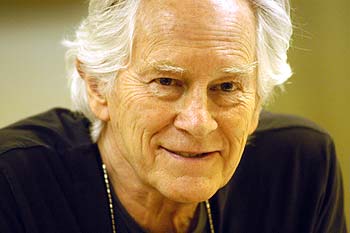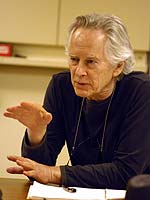 |
Beat poet, essayist and playwright Michael McClure. (Peg Skorpinski photos) |
Beats go on in the archives of UC Berkeley's Bancroft Library
BERKELEY – The University of California, Berkeley's Bancroft Library - already home to the archives of some of the most noted poets of the Beat era - has acquired journals of prolific poet, essayist and playwright Michael McClure that date back to the West Coast birth of the Beats in the 1950s.
McClure, now 70, was on stage at The Six Gallery in San Francisco in October 1955 when Allen Ginsberg unleashed his first public reading of "Howl. " McClure read poetry that night, too. So did fellow Beat Philip Whalen, whose archives also are at The Bancroft Library. And Gary Snyder and Phillip Lamantia were part of lineup at the club, converted from an auto garage for the poetry-with-music Beat generation.
Jack Kerouac was in the audience, collecting money for wine and punctuating the rhythms of the readers by shouting, "Go!" at the end of each line.
"He (McClure) was in at the beginning," said Anthony Bliss, curator of rare books and manuscripts at The Bancroft Library. "This adds considerably to our collection of San Francisco's literary and cultural scene. It's really major."
"His papers are in wonderful order," Bliss added. "For a beatnik, he was wonderfully organized."
One reason McClure's chose UC Berkeley to house his personal writing rather than another institution, Bliss said, was that the Oakland resident could have easy access to it.
McClure said he's making incredible headway at The Bancroft going through his journals in a large, quiet room lined with books. "I'm quite comfortable here, and the main thing is privacy," he said on a recent visit. "I like being here, knowing that (painter) Jay DeFeo's archives are here, that Philip Whalen's archives are here."
The Bancroft's Beat archive is significant, added Lawrence Ferlinghetti, former poet laureate of San Francisco and owner of City Lights Bookstore and publishing company, "Anyone who's writing about the Beat generation would have to consult it."
 'I'm quite comfortable [at the Bancroft], and the main thing is privacy. I like being here, knowing that [painter] Jay DeFeo's archives are here, that Philip Whalen's archives are here.' -Michael McClure
|
To date, McClure has published 16 books of poetry, two novels, six books of essays and 10 plays. He has performed at universities and clubs around the world. He's had feature roles in several films. His essays have appeared in Rolling Stone and Vanity Fair. McClure collaborated with musician Ray Manzarek, of the Doors and Jim Morrison fame, for live poetry readings set to music and to produce a jazzy performance video, "Love Lion."
A constant on the San Francisco scene, McClure joined Ginsberg and Snyder at Golden Gate Park in San Francisco for the "Human Be-In" in January 1967. In April of this year, he recited a poem, "Imagine Peace," as rain fell at a peace rally at San Francisco's Civic Center Plaza.
The poets at The Six Gallery in 1955 spoke their minds and found they were expressing what their listeners were feeling, too.
McClure added that three of the six poets that October night read poems about nature, and that the Beats represented "the literary wing of the environmental movement."
One of his early works was "Peyote Poem," part of which describes a peyote flashback he experienced while just outside The Bancroft Library, near the Campanile. He also wrote a book of 99 poems in an invented language, and described what happened that night at The Six Gallery in "Scratching the Beat Surface."
McClure attracted attention with his play, "The Beard," a story of actress Jean Harlow and outlaw Billy the Kid locked together in a room for eternity. The San Francisco police shut down the play, because it ended with a simulated sex act.
"That's like arresting the actors at the end of 'Hamlet' for killing all those people," said Ron Loewinsohn, a UC Berkeley professor of English.
McClure's most recent books of poetry are "Huge Dreams" and "Touching the Edge, Dharma Devotions from the Hummingbird Sangha."
In progress is a marriage poem that he said might include a few lines from Emily Dickinson, and a long prose piece about a 1962 trip into the mountains near Oaxaca with an environmentalist friend. McClure's also writing another poem, "Dear Being, " about old age and being in love.
On his regular visits to The Bancroft Library, he dips into his journals for material.
"What I remember very clearly in my mind, I didn't bother to write down," McClure said. Now, he has additional notebooks, to expand upon his old journals with his recollections. The original journals reflected more of the "wrestling of great creation" than specific events or observations, he said.
McClure said he has discovered that he wrote nothing of that eventful night at The Six Gallery, or about traveling around the world.
Since he was quite young, McClure has followed a regimen, with designated time to write, to practice Zen, and to pursue other activities.
McClure always kept a journal on his desk, filling it with creative notes, thoughts and observations, Bliss said. When one journal was full, McClure filed it and opened a new one.
"He says he's got at least two more books in those notes," said Bliss. McClure's meticulous organization of his papers is another gift to the library, since it can more easily process the materials and make them available to scholars and researchers. The Bancroft has two state-funded archivists, but many extensive collections to catalog and prepare for use.
Other Beat era archives still coming to the library include the correspondence, notebooks, manuscripts, e-mail correspondence and postcard "mail art" of David Meltzer, another of the original Beat poets.
Meltzer, who lives in El Cerrito, corresponded with major figures of the Beat era, Bliss said.
"He's so important because he's been here for such a long time," Loewinsohn said. "He was in contact with so many important people in the Bay Area, California and back East. The collection will be important for what it tells us about others."
A collection that recently arrived at The Bancroft features the journals, artwork and letters of Aya Tarlow, who was married to Los Angeles filmmaker and artist Elias Romero. Tarlow was an active participant in the Southern California Beat scene during the 1950s and '60s. She now lives with Meltzer.
"This material is just terrific," Bliss said. "She was there. It's first-hand, eyewitness accounts of what was going on, who the players were, what they were doing. This dovetails nicely with what we already had."
Ferlinghetti of San Francisco's City Lights noted that Meltzer also was very involved with Beats outside of the San Francisco area and performed as a guitarist.
Other Beat material at The Bancroft includes the archives of Ted Joans and of Ferlinghetti, who encouraged the disillusioned and rebellious Beats as they emerged.
The archive also includes the rich materials of City Lights Publishers, which published Kerouac, Ted Joans, William S. Burroughs, Diane Di Prima, Gregory Corso, Neal Cassady and many other Beats.
"When you have City Lights, you have everybody," said Bliss.
City Lights celebrates its 50th anniversary in June with a series of events, including a poetry dance with McClure. Asked if he had performed a poetry dance before, McClure answered, "I've done everything."

